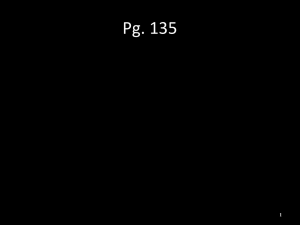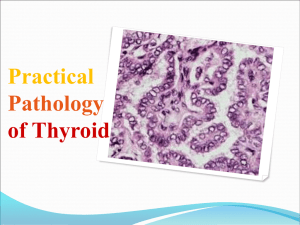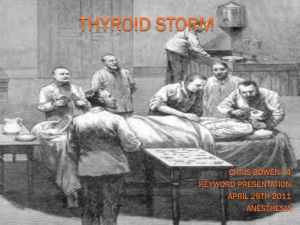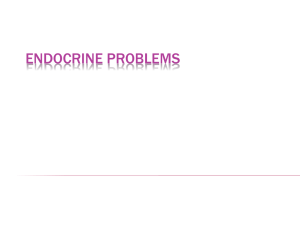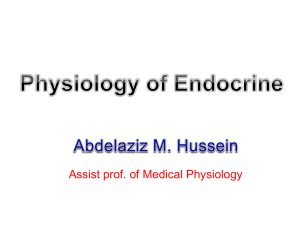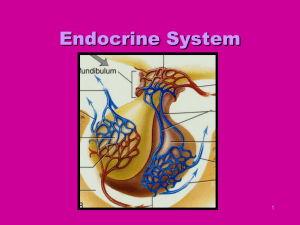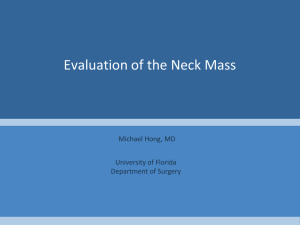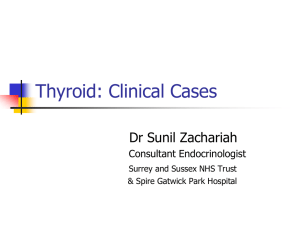Parathyroid glands
advertisement
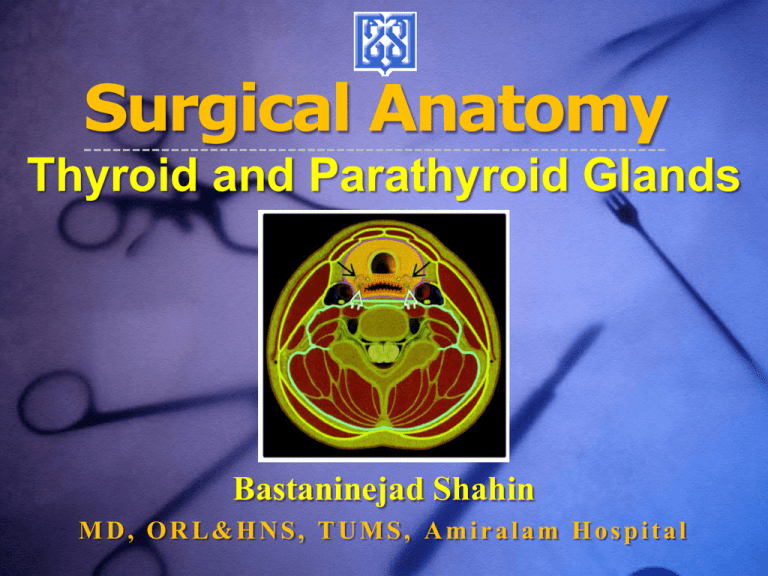
Surgical Anatomy Thyroid and Parathyroid Glands Bastaninejad Shahin MD, ORL&HNS, TUMS, Amiralam Hospital Presentation outlines • Thyroid Gland: • General measures • Vascular supply • Important proximities • Surgical approaches and important Landmarks • Parathyroid glands: • General measures • Surgical localization • Thyroid Function Tests Thyroid Gland General measures • • • • • • Two lateral lobes connected with isthmus Total weight is about 15 to 25 g Each lobe: 4 x 1.5 x 2cm (height/width/depth) Extends from C5 to T1 vertebra Isthmus is over 2nd & 3rd tracheal ring Approximately 40% of patients have a pyramidal lobe that arises from either lobe or the midline isthmus 40% present General measures... • Cervical Fascia: – True Thyroid Capsule – Surgical Capsule – Berry’s Ligament (connecting the lobes of the thyroid to the cricoid cartilage and the first two tracheal rings) • Surgical Approaches regarding to the Fascia: – Intracapsular Thyroidectomy – Extracapsular Thyroidectomy – Combine!? Berry’s Ligament Vascular Supply • Two pairs of arteries • Three pairs of veins • Connecting vessels within the thyroid true capsule • In less than 10%, there is a midline arterial supply to the gland, named as Thyroid Ima artery Important proximities About 12cm About 5-6cm Non-recurrent LN, Less than 1% Can be find in only 10-30% of the times 1 cm Surgical approaches and Landmarks • The course of the inferior laryngeal nerve is highly variant • Incidence of nerve paralysis is three to four times greater in cases in which the recurrent nerve was not localized compared with cases in which it was • Try to seek, expose and identifying the nerve, instead of avoiding it! • Extracapsular approach with nerve identification is the method of choice The most common course of Incidence is the nerve ismore within TEinGroove higher Revision cases (48.5% - not depicted here) 42.2% 5.4% 3.9% Extralaryngeal Branching (35.5% in some reports up to 80%!) Surgical approaches and Landmarks • Lateral Approach – Inferior Thyroidal Artery – Tubercle of Zuckerkandl (ZT) • Inferior Approach – Lore’s triangle – Tracheoesophageal Groove • Superior Approach – Posterolateral aspect of the Cricoid – Berry’s ligament – Inferior border of the inferior Constrictor – Inferior horn of the thyroid cartilage ...Lateral Approach • Used most commonly • RLN is identified typically at the thyroid midpole level (less nerve dissection required) • This approach is less useful for Revision ZT is Present in 63-80% of the patients ...Inferior Approach • Used for Revision cases and Goiter surgery (not substernal) • Problem: Longer nerve dissection and probability of Parathyroid glands ischemia • Benefit: nerve will be find before any extralaryngeal branching ...Superior Approach • Used for large substernal Goiters • Nerve is at the lower edge of the lateral aspect of the cricoid cartilage • Nerve should be identified just caudal to the lowest fibers of the inferior constrictor Parathyroid Glands General measures • • • • Two pairs: Superior and Inferior Weight is about 50 to 70 mg Size 5 x 3 x 1 mm Color of normal parathyroid glands ranges from yellowish brown to reddish brown • 87% there are four glands (super numerary glands are usually in the mediastinum or thymus gland) • Their Arterial supply is usually from Inferior Thyroid artery (80%) Surgical Localization • Superior Parathyroid Glands – 80% they are at the cricothyroid junction approximately 1 cm cranial to the juxtaposition of the recurrent laryngeal nerve and the inferior thyroid artery. – Ectopic glands: it cloud be intrathyroid, paraesophageal, retroesophageal and mediastinal (posterior superior compartment) ...Surgical Localization • Inferior Parathyroid Glands: – More variable location – More than 50% of the inferior parathyroid glands are situated near the lower pole of the thyroid gland – Ectopic glands: it could be situated in thyrothymic ligament (28%) or mediastinum (Anterior superior compartment) Thyroid Laboratory Tests Thyroid Function Tests TSH FT4, (T4) FT3, (T3) Thyroglobulin Thyroid stimulating immunoglobulin (TSI) Antithyroid peroxidase antibodies (AntiTPO) RAIU Serum TSH • Single best initial test of the thyroid function • Normal range 0.5 – 5.0 mU/L • If TSH alone is the first line test, what diagnoses will be missed? 1. Pituitary disease or tumors 2. Hypothyroidism develops within 12 months of treatment for thyrotoxicosis (the TSH value remains suppressed) 3. Thyroid hormone resistancy 4. Non-thyroidal illness (NTI) 5. Pregnancy – In these cases testing of free thyroid hormones is recommended in addition to the TSH assay (FT4 + TSH) Screening Recommendations • Various societies and authors disagree about population-based screening • There are insufficient evidences to recommend for or against routine screening for thyroid disease in adults. • The AAFP recommends screening high-risk populations: - women with a family hx of thyroid disease - women >35 y.o. - pregnant women - abnormal physical exam - diabetic patients - Hx of autoimmune disorder • The American Thyroid Association (ATA) recommends screening start at age 35 (and q 5 years after that) Serum T4 • Serum total T4 assays measure both bound and unbound (“free”) T4 • Levels are high in approximately 90% of hyperthyroid patients and low in approximately 85% of hypothyroid patients. Serum Free T4 • FT4 is measured by equilibrium dialysis techniques or estimated indirectly by calculation of free-thyroxine index (FTI) • FT4 assay is preferred test with TSH or when TSH is high T3, Free T3, and rT3 • T3 – binding protein dependent – Levels can be misleading in patients with acute illness, cirrhosis, uremia, or malnutrition • FT3 - Useful to distinguish T3 toxicosis from subclinical thyrotoxicosis - When TSH is low, a free T3 assay should be obtained - Measurement of fT3 is not indicated in hypothyroidism • Reverse T3 (rT3) - increased in NTI - it is an inactive hormone - helpful to exclude central hypothyroidism Other Ancillary Tests • Serum thyroglobulin – produced and released by thyroid gland – marker for recurrent thyroid cancer – differentiate Graves disease from factitious thyrotoxicosis • Serum thyroid-stimulating immunoglobulin (TSI) – Expensive test – Graves’ disease. • Antithyroid peroxidase antibodies (Anti TPO) – organ-specific and sensitive. – Hashimoto’s thyroiditis – predict overt hypothyroidism (use in subclinical hypothyroidism) Other… • Radioactive iodine uptake (RAIU) – A very high RAIU is seen in individuals whose thyroid gland is overactive (hyperthyroidism) – A low RAIU is seen when the thyroid gland is underactive (hypothyroidism)

